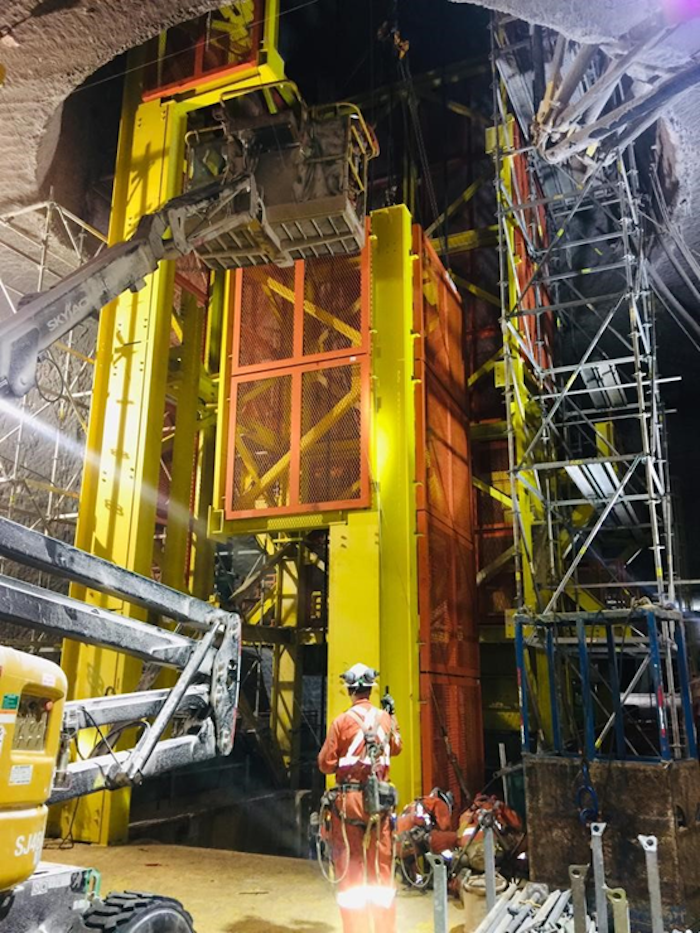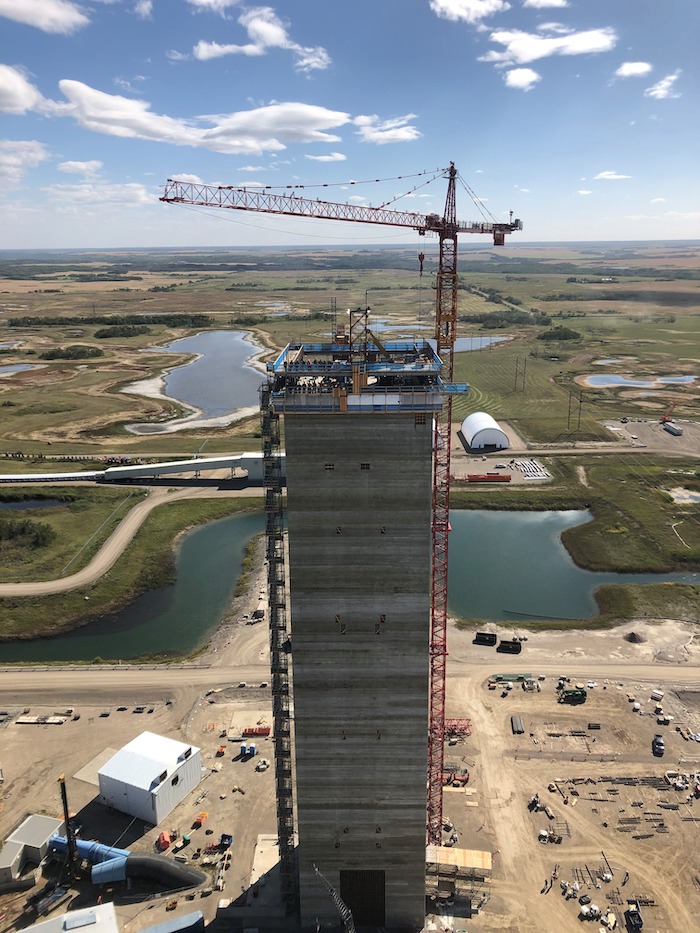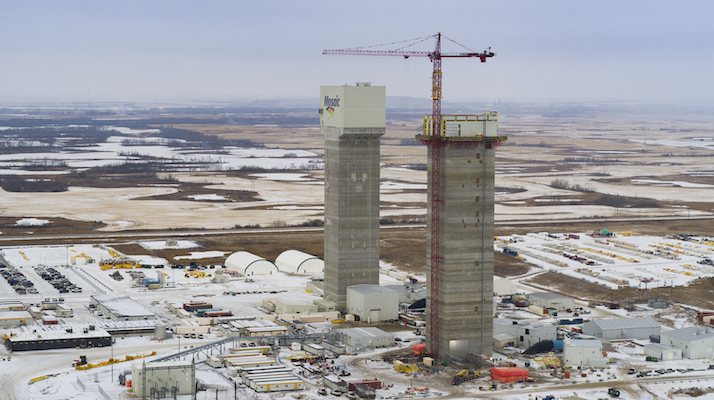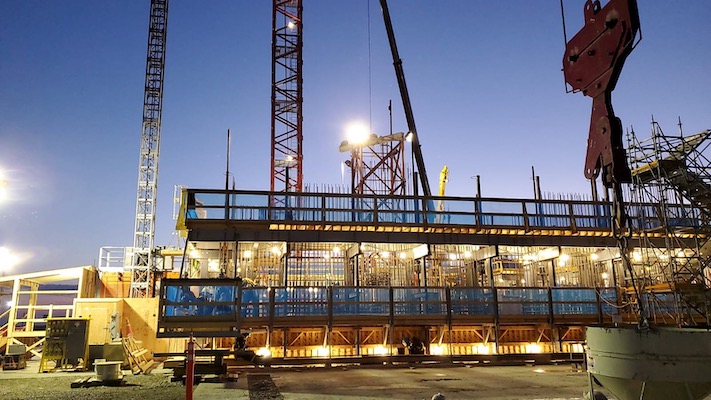
2023 #CCEAwards Showcase: K3 Expansion – South Shaft Headframe
October 20, 2023
By CCE
“An impressive operation that reduced risks to workers by eliminating working at heights or in confined spaces. It’s good to see a project really emphasize health and safety as a design principle.” – Jury
Category: Natural Resources, Mining, Industry and Energy
Schreyer Award and Award of Excellence Winner: Hatch
With headframes rising over 350 ft above surface and shafts linking to the underground development 3,350 ft below, mining company Mosaic’s K3 expansion project in Esterhazy, Sask., is one of the largest and most competitive underground potash mines in the world.
Replacing the existing K1 and K2 underground mines—now decommissioned—the K3 expansion project was designed and constructed with a focus on modernization and efficiency, to avoid and mitigate any potential future environmental impacts.
Hatch managed the engineering and construction of the shafts, headframes and hoisting systems, deploying new techniques that successfully achieved project safety goals and enabled the final phase of the project to finish ahead of schedule and under budget.
A novel approach
The greenfield K3 expansion project consisted of:
- two 3,500-ft production shafts.
- two 350-ft headframes.
- hoisting systems for production and personnel.
- surface infrastructure and underground development.
As part of Mosaic’s mandate to execute a safe and expedited project, Hatch deployed its construction and modularization groups to develop solutions that would minimize the construction timelines. By leveraging the firm’s knowledge already gained from the conventional construction of the north shaft headframe, the team implemented advanced modularization techniques in the south shaft headframe.
Structural steel pre-assembled modules (PAUs) were connected into floor sections on ground level. After each floor was assembled, permanent equipment was installed and construction materials were loaded.
Once loaded, each of the six floors was raised as an individual unit on a proprietary-design jacking system with over 1,000 t of lifting capacity. At elevation, each floor was pinned into the walls of the headframe.
In comparison to conventional stick-built construction, this innovative approach provided significant safety and production advantages, including:
- a significant reduction of direct hours working at height.
- a reduced risk for falling objects.
- more than 12 months of scheduling savings.
- significant execution costs savings.
Such innovations were not only executed on the surface above the mine, but also deployed within the confines of the shafts. Despite the constraints of a 3,500-ft shaft measuring only 20 ft in diameter, Hatch delivered an underground modular approach that had never been executed before.

By leveraging Hatch’s knowledge already gained from the conventional construction of the north shaft headframe, the team could implement advanced modulization techniques in the south shaft headframe. Photo courtesy Hatch.
With an eye toward minimizing the risk of welding within the confines of a wet shaft, the team identified an opportunity and developed a novel solution: to lower each of the 150-t flasks in a single section.
“The scope was like any other structural erection,” says project manager Chris Congram, “except it was happening 3,500 ft below surface, with modules varying in height, weight, shape and size, each requiring unique lift-and-rope management plans. Using the existing shaft-sinking hoists required a high level of planning, teamwork and communication.”
Together with multiple contractors, Hatch and Mosaic reviewed the feasibility plan and implemented key modifications to the execution strategy. The work was completed by a fully integrated team, with a successful outcome, as more than 150 t of steel was lowered and erected at the shaft’s bottom in less than one week, without any safety incidents, saving 18 days off the critical path schedule.
The success of the project gained industry-wide recognition, resulting in plans to repeat a similar ‘fully built flask’ lowering process in other potash mines across Saskatchewan.
One of the most complex slipforms
Due to its continuous construction and reinforcement requirements, along with its scope and lack of internal structure, the south shaft headframe slipform was exceptionally complex.
The structure had to hold more than 2,000 t of suspended structural flooring. With more than 342 embedded plates, 43 blockouts and 3 million lb of rebar, the south shaft headframe was indeed one of the most challenging slipforms ever performed.
Every hour, more than 2.5 t of reinforcement was installed; and every day, more than 225 m3 of concrete was poured. Extensive planning, constructability reviews and re-engineering were required to co-ordinate the construction effort, which ran 24 hours a day.
Complicating the challenge further, the team had to execute the slipform during the global COVID-19 pandemic, when they were tasked with co-ordinating the mobilization of expertise from key resources across closed international borders.
The team successfully managed significant contractor commercial challenges, including a force majeure, and ultimately completed the slipform safely, under budget and ahead of schedule. It was a true success story for both Hatch and Mosaic.
A hub of employment
As a leading employer in Saskatchewan, Mosaic focused on the development of local business, specifically working with vendors and contractors within the surrounding regions. Representing more than 10 years of execution, including engineering, project management and construction, the K3 expansion project provided more than 12 million employment hours for a primarily Saskatchewan-based workforce.
Two key contractors—both major contributors to the project surface and underground works—established new permanent offices in the town of Esterhazy. With these contractors living and working in the area, the project can continue to provide further employment opportunities for local communities.
A local concrete batch plant was awarded the scope for the execution of the south shaft headframe slipform. While this represented a massive undertaking for the family-owned company, Hatch worked with them to develop procedures and prepare for the execution of the 5000-m3, 22-day continuous pour. Despite some challenges, the concrete was supplied safely and with exceptional quality. In addition, as part of the execution, with Hatch’s support for diversity on this aspect of the project, the concrete supplier fielded an all-female crew for one of two shifts during the execution of the slipform.
Avoiding environmental impacts
The project was designed to maximize efficiencies and minimize the use of energy and natural resources, thus helping to reduce Mosaic’s environmental footprint.
Throughout the design, construction and operation of the K3 expansion, there was a key focus on avoidance and mitigation of environmental impacts. Studies were completed with the implementation of key mitigations, including the use of consultants in the field to provide guidance and leadership during construction. Detailed air quality studies and testing were completed to ensure minimal impacts and compliance with permits and approvals.
Now in operation, the K3 mine was constructed at a profound time in line with current demands for environmentally efficient food production. The world-class project is a benefit to millions of people as a reliable source of fertilizer production for the agricultural industry for decades to come.

The exceptionally complex south shaft headframe slipform was finished safely, under budget and ahead of schedule. Photo courtesy Hatch.
A significant commitment
When the existing K1 and K2 mines were decommissioned due to the water inflow, Mosaic and Hatch accelerated the final K3 project phase and achieved operational milestones ahead of schedule. The hoists, now fully operational, are capable of lifting more than 21 million t of potash to the surface each year.
The K3 expansion project signifies a commitment to the long-term sustainability of Mosaic’s operations. Potash is an essential element in fertilizers and the K3 mine is Mosaic’s flagship development that will help the world grow the food it needs in the years to come.
The modularization strategy, in particular, could revolutionize mining construction concepts and projects in the future. Equipment lowering, once a long and arduous process, can now be optimized through the lowering of larger components underground. Key components of the loading pocketing, including the flasks at the base of the mine shaft, can now be safely constructed outside the shaft barrel and then lowered as pre-assembled units.
Modular approaches like those used on the south shaft headframe demonstrate new ways to prioritize safety through the reduction of work at heights, while optimizing schedules and minimizing costs. With these advanced techniques in place, workers and production timelines are protected from the risks posed by conventional stick-built methodologies.
K3 Expansion – South Shaft Headframe, Esterhazy, Sask.
Award-winning firm (engineering, procurement and construction management): Hatch, Mississauga, Ont. (Chris Congram, P.Eng.; Rafi Abu, P.Eng.; Adam Bale, P.Eng.; Levi Thoner, P.Eng.; Collin Watson, P.Eng.; Dan Bennett; James Kavanagh; Scott Williamson; David Meldal-Johnsen; Peter Gray).
Owner: Mosaic.
Other key players: DLT Engineering (hydraulic jacking system), ABB (production hoist).

